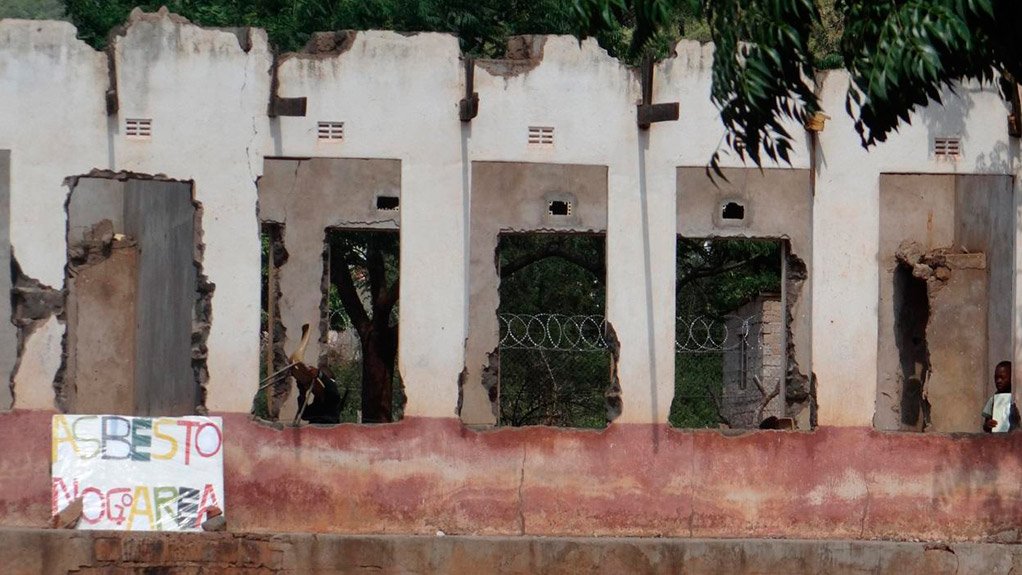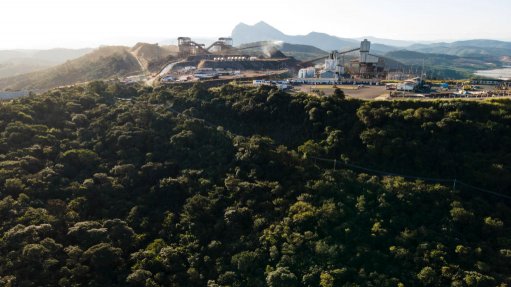Lack of funds hampers rehabilitation of derelict, ownerless asbestos mines


LASTING LEGACY An abandoned building built using asbestos shows the legacy of the cancer-inducing resource on the built environment
State-owned mineral and metallurgical innovation organisation Mintek is struggling to meet its mandate to rehabilitate derelict and ownerless asbestos mines and related workings, owing to a lack of funding.
Speaking at the annual general meeting of the Kgalagadi Relief Trust, in Johannesburg, on November 14, Mintek sustainable development head Herman Cornelissen said that, although asbestos mining in South Africa had ceased, the issue of rehabilitating legacy asbestos mines and dumps remained.
He added that, although a number of old asbestos mines met their legal obligation by rehabilitating their mine works to the standards set by the mining authority of the time, some of the rehabilitation work was being undone by nature and the prevalence of illegal mining meant some people were exposing themselves to high levels of the cancer-inducing resource as they ventured into old mines in search of salvageable equipment and cables.
The majority of old asbestos mines are located in the Northern Cape. Domestic production of asbestos reached 221 111 t/y in 1983, with about 95% of this production being exported to mostly European and East Asian countries.
South Africa had a total of 249 known (formal and informal) asbestos mines, which posed and continue to present differing problems in terms of the types of historical and current exposure to asbestos fibres.
Cornelissen pointed out that mining legislation had also transformed over the past 100 years, guiding miners to approach tailings and mine closure in different ways, some of which were contributing to the current dilemma whereby previously covered asbestos dumps were being unearthed by the wind.
Legacy Legislation
In 1903, the Transvaal Mining Laws required asbestos mines to erect fences and use backfill to improve safety in mines. This was amended during the period1931 to 1951 with the promulgation of the Mines, Works and Machinery Regulations, which stipulated (among other things) minimum distances to structures. Both pieces of mining legislation provided only for the ‘safemaking’ of operations, Cornelissen said.
However, in 1956, the Mines and Works Act gave rise to the first steps towards basic planning for environmental recovery, notes Cornelissen. This legislation introduced rehabilitation plans, such as treating top soil and vegetation recovery.
The 1991 Minerals Act was a step towards increased awareness of the environment, he said, with this legislation requiring miners to develop an environmental management plan, consult on mine closure and closure plans, and conduct life cycle planning and monitoring, as well as heed other environment guidelines.
The Mineral and Petroleum Resources Development Act (MPRDA), introduced in 2004 and currently in effect, positioned society as an integral part of the regulatory environment, said Cornelissen, as it incorporated social and labour plans and provided for integration with the National Environmental Management Act and the National Water Act. It also incorporated sustainable development principles.
Current Funding Model
Therefore, while all asbestos mining ceased in 2001, the introduction of the MPRDA in 2004 set adequate environmental procedures in place after asbestos mining cessation, creating a volume of historical asbestos mines requiring modern and renewed methods for their ‘safemaking’ and reclosure and remediation.
Asbestos mine rehabilitation is entirely funded by government – taxpayer money – stated Cornelissen, adding that current revenue for general mine rehabilitation came from a yearly budget of R50-million, as set out in the prevailing Medium-Term Budget to 2019.
In 2009/10, Mintek undertook its first contract to rehabilitate four asbestos-mine-related works. These projects, which went beyond the mines proper, included Owendale, Strelley, Jebolo and the Prieska mill site – costing a total of R19-million.
The second contract, from 2010 to 2013, cost R90-million and involved 14 projects, namely Bestwell, Heuningvlei, Lokaleng, Vergenoegd, Ga-lotolo, the Prieska mill wall, the Prieska old hospital, the Heuningvlei revegetation, the Penge rehabilitation and revegetation, the Penge Maretlwane dump, Kromellenboog, Langley and Mafefe Kappa.
At a cost of R165-million, Mintek undertook its third contract between 2013 and 2016 to rehabilitate 11 projects, namely the Strelley revegetation, Mahlatjane, Ditabogong, Lusikisiki, Klipriver, Mang-le-mang, Ga-madiba, Sithilo, Betle and Buisvlei North and South.
Beginning this year and extending into 2019, Mintek plans to use R150-million to undertake 15 projects (one of which has already been completed). This contract includes Motswane (work in progress), four subprojects at Streatham and ten others on public land.
Comments
Press Office
Announcements
What's On
Subscribe to improve your user experience...
Option 1 (equivalent of R125 a month):
Receive a weekly copy of Creamer Media's Engineering News & Mining Weekly magazine
(print copy for those in South Africa and e-magazine for those outside of South Africa)
Receive daily email newsletters
Access to full search results
Access archive of magazine back copies
Access to Projects in Progress
Access to ONE Research Report of your choice in PDF format
Option 2 (equivalent of R375 a month):
All benefits from Option 1
PLUS
Access to Creamer Media's Research Channel Africa for ALL Research Reports, in PDF format, on various industrial and mining sectors
including Electricity; Water; Energy Transition; Hydrogen; Roads, Rail and Ports; Coal; Gold; Platinum; Battery Metals; etc.
Already a subscriber?
Forgotten your password?
Receive weekly copy of Creamer Media's Engineering News & Mining Weekly magazine (print copy for those in South Africa and e-magazine for those outside of South Africa)
➕
Recieve daily email newsletters
➕
Access to full search results
➕
Access archive of magazine back copies
➕
Access to Projects in Progress
➕
Access to ONE Research Report of your choice in PDF format
RESEARCH CHANNEL AFRICA
R4500 (equivalent of R375 a month)
SUBSCRIBEAll benefits from Option 1
➕
Access to Creamer Media's Research Channel Africa for ALL Research Reports on various industrial and mining sectors, in PDF format, including on:
Electricity
➕
Water
➕
Energy Transition
➕
Hydrogen
➕
Roads, Rail and Ports
➕
Coal
➕
Gold
➕
Platinum
➕
Battery Metals
➕
etc.
Receive all benefits from Option 1 or Option 2 delivered to numerous people at your company
➕
Multiple User names and Passwords for simultaneous log-ins
➕
Intranet integration access to all in your organisation



















